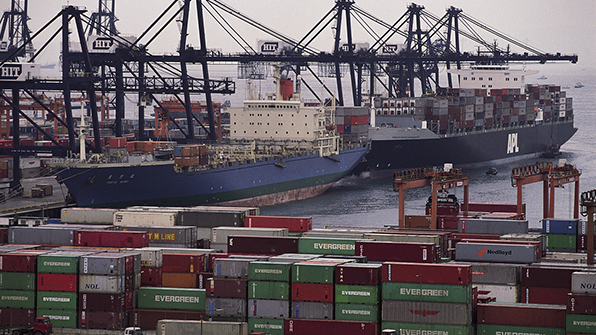Corporate Korea (5)
The following is the fifth (Chapter 4 summary) in a series of articles on the book, entitled “Corporate Korea’.—Ed.
By Kim Kwang-sooh
After undergone several hardships and instabilities for more than a decade since its Independence in 1945, Korea experienced the first oil shock in 1973 and second one in 1979 when its heavy and chemical industry largely relied on oil for energy.
The government adopted the heavy and chemical industry in early 1970 as export of light industry products faced limitation. Major business areas in the heavy and chemical industry included steel and iron, metal, machinery, electronics, shipbuilding and chemicals.

To help companies start these businesses with less investment, the government built industrial complexes in a number of regions while expanding social overhead capitals (SOCs), including ports, industrial water and roads. In early stage of the heavy and chemical industry promotion policy, the government played active role in implementing it, but it focused on encouraging private companies to enter such businesses without intervening in their management.
This position was demonstrated by establishing only two state-run companies in heavy and chemical segments, such as POSCO and Korea Integrated Chemical, whose products accounted for 10% of the gross national product (GNP) in those days.
As the Korean economy fell under control of the International Monetary Fund (IMF) due to the currency crisis in December 1997, the IMF recommended Korea to conduct structural reformation on condition of providing bailouts. In an effort to get over the IMF control early, the government announced the plan of reforming 4 segments, including finance, enterprise, labor and public. In financial segment, the government restructured financial industry to reduce 30% of some 2,100 financial institutions by means of cancellation of approval, merger, dissolution or suspension of business.
In enterprise sector, the government agreed with large enterprises to restructure businesses through measures such as big deal, and improvement of financial structure and governance structure. To reform the labor segment, the government, industry and labor unions made joint efforts to improve labor market. And the government privatized 11 public enterprises out of 24 enterprises.
Coupled with the IMF’s control and financial crisis in Southeast Asian countries, large corporate groups in Korea, including Hanbo Iron and Steel, Daewoo Group, Sammi Group, Jinro Group, Kia Group, Haitai Group, New Core Group, and Hanra Group, were bankrupted or liquidated.
Among them, 34-year old Daewoo Group, which once emerged as one of the world’s largest multinational enterprises based in an emerging country, was dubiously broken up. Some large business groups made big deals each other. One example was the acquisition of LG Semiconductor by Hyundai Electronics in 1998, changing its name to Hynix. Then the SK Group acquired Hynix in 2012 with subsequent heavy investments.
And other corporate groups had to take strong restructuring measures for survival, focusing on improvement of governance structure. Major factors of their crisis were pointed to be high debt-to-equity ratio, overinvestment, fleet-type management and lagged governance structure. Since the currency crisis, the Korean economy has continued slow growth.
The annual economic growth rate steadily dropped from 10.1% in 1999~2000 to 2.8% in 2015~2016. The number of large enterprises with over 300 employees barely increased from 2,806 in 1993 to 3,343 in 2012, but that of large manufacturing enterprises decreased from 1,223 to 687 during the same period.
Attributing to surge in export started in the early 1960s, the Korean economy achieved unparalleled annual growth of over 10% during the 1960s and 1970s. Major export items in those days included labor-intensive light industry products, such as clothes, textile, shoes and wig.
Total export amount of these products increased from $36,000 in 1961 to as much as $349.2 million in 1970. But as export of light industry products faced limitation in the late 1960s, the government began to place higher priority on export-oriented heavy and chemical industry in early 1973.
export items in the 1970s and 1980s were electric/electronic products, steel and iron products, ships, automobiles, petrochemical products and semiconductors. The proportion of export contributed to Korean economic growth reached 38% in the 1970s, and dropped to 23% in 1991~1995, but it rose again to 43% in 1996~2000 and 65% in 2001~2005. In 2011, Korea achieved $500 billion in export and $1 trillion in trade amount. This growth was largely indebted to export-oriented industrial policy rather than import substitution-oriented industrial strategy.
In line with rapid economic growth and increase in export, Korea began to open its market to the world in April 1967 when it became a member of the GATT (General Agreement on Tariffs and Trade) and participated in the Kennedy Round.
The liberalization rate increased from 58.5% in 1967 to 68.6% in 1978 and then to 99% in 1996 while lowering average import tariff rate to 18.1% in 1988 and then to 7.9% in 1993. In November 1980, Korea introduced the import diversification measure, but it had to abolish the system on phased basis at international trade pressure after the Uruguay Round negotiations were concluded.
Under the World Trade Organization (WTO) system, Korea removed import diversification items in June 1999 in entirety from 113 items in 1997. Having relied on multilateral trading systems such as the GATT and WTO up until the 1990s, Korea joined in regional trade agreement system, or bilateral free trade agreement (FTA) since then. Since it decided to seek the FTA with Chile in 1998, Korea effectuated 15 FTAs with other countries by June 2018.
Korea-Chile FTA took effect in April 2004, and the Korea-United States FTA was signed in June 2007. These were followed by the Korea-Singapore FTA effectuated in March 2006, Korea-EFTA (European Free Trade Association) FTA effectuated in September 2006, Korea-ASEAN (Association of South East Asian Nations) FTA effectuated in June 2007, and Korea-India FTA that came into effect in January 2010, to name some of them.

